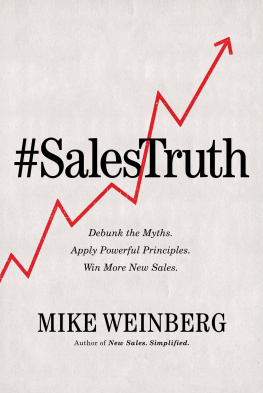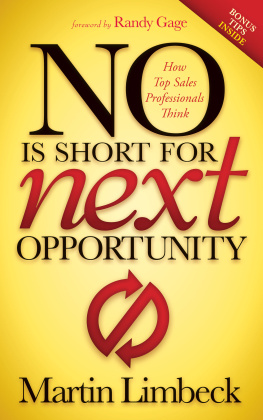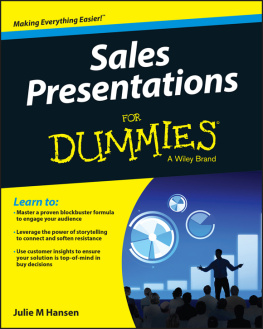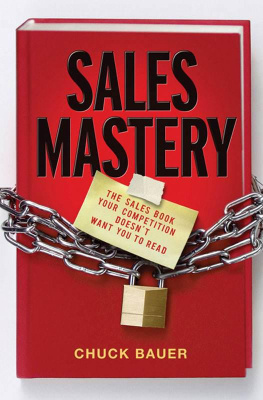Contents

Cover image: Name Tag Francisco Fernandez/istockphoto
Cover design: C. Wallace
Copyright 2013 by Nadine Keller. All rights reserved.
Published by John Wiley & Sons, Inc., Hoboken, New Jersey.
Published simultaneously in Canada.
No part of this publication may be reproduced, stored in a retrieval system, or transmitted in any form or by any means, electronic, mechanical, photocopying, recording, scanning, or otherwise, except as permitted under Section 107 or 108 of the 1976 United States Copyright Act, without either the prior written permission of the Publisher, or authorization through payment of the appropriate per-copy fee to the Copyright Clearance Center, 222 Rosewood Drive, Danvers, MA 01923, (978) 750-8400, fax (978) 646-8600, or on the web at www.copyright.com . Requests to the Publisher for permission should be addressed to the Permissions Department, John Wiley & Sons, Inc., 111 River Street, Hoboken, NJ 07030, (201) 748-6011, fax (201) 748-6008, or online at www.wiley.com/go/permissions .
Limit of Liability/Disclaimer of Warranty: While the publisher and author have used their best efforts in preparing this book, they make no representations or warranties with the respect to the accuracy or completeness of the contents of this book and specifically disclaim any implied warranties of merchantability or fitness for a particular purpose. No warranty may be created or extended by sales representatives or written sales materials. The advice and strategies contained herein may not be suitable for your situation. You should consult with a professional where appropriate. Neither the publisher nor the author shall be liable for damages arising herefrom.
For general information about our other products and services, please contact our Customer Care Department within the United States at (800) 762-2974, outside the United States at (317) 572-3993 or fax (317) 572-4002.
Wiley publishes in a variety of print and electronic formats and by print-on-demand. Some material included with standard print versions of this book may not be included in e-books or in print-on-demand. If this book refers to media such as a CD or DVD that is not included in the version you purchased, you may download this material at http://booksupport.wiley.com . For more information about Wiley products, visit www.wiley.com .
ISBN 978-1-118-42837-5 (cloth); ISBN 978-1-118-51959-2 (ebk);
ISBN 978-1-118-51961-5 (ebk); ISBN 978-1-118-51962-2 (ebk)
To the men in my life :
My dad, my husband Peter, and my two phenomenal boys, PK and Christopher
Acknowledgments
T hank you everyone at Wiley, especially you, Daniel Ambrosio for finding me! Christine Moore, my goal is to channel you!
I am so grateful for my husband Peter, and my two boys, PK and Christopher. I will never forget our first editorial session, on a beautiful summer day in the field, as we scoured the first 30,000 words! Thank you for your love and support throughout this process and for always being champions of my career. I am so proud! Christopherwho knew that a teenage boy could be a responsible and insightful intern to his own mother? You did a great job (except for that day when you fell asleep reading my manuscript). I think we broke records, and your editing skills make it easier to write those tuition checks!
Melindayou make me laugh every day. It seems such a clich to say that you are the wind beneath my wings, but, what the heck, you are and you always have been.
Dadyou are my number-one cheerleader... even at age 94!
Linda Knox, Kathleen Johnson, Kristin Arnold, and Erin Hubbard you inspire me. Thanks, girlfriends!
Eric Baronyou are the master! Thank you for your generosity and support over the years.
Denise, HT, Ian, Ron, Lionel, and Jim, thank you for your contributions.
Thanks, Trish Loger, for your wonderful cartoons, and Doug Barron, for all your help on this and all other projects, old and new.
I am honored to be a coach to many wonderful professionals. Thank you for allowing me into your lives. It has been my privilege, and I have learned so much!
Introduction: Creating an Experience
W e have been boring each other for years during sales presentations.
If you have ever been a member of a buying committee, you surely know what its like to sit through a page-by-page turn of a presentation that is more easily measured in pounds than ounces.
Perhaps you have heard salespeople drone on about the size of their firm, their clients, and their products. Or watched some poor souls read bullet point after bullet point of detailed information about their company that is of little interest to their audience.
Maybe youve witnessed someone respond to a simple yes-or-no question with a five-minute response that never really seems to answer the initial query. Or you may have even experienced that awkward and uncomfortable moment when a member of the buying committee says to the sales team, I am sorry, but we are going to have to end now. Your time is up. Yikes!
These scenarios are abundant in sales presentations. They often come as a result of unstated traditions, myths, and rules that have been so ingrained in corporate America that they have become commonplace.
Lets face it, the bar has been set lowvery low.
And because these scenarios are often accepted behavior, people have been successful in spite of it.
Early in my career, I was responsible for the investor, client, and employee communications for a man named Bill Harrison, who was the vice chairman of the Chase Manhattans Global Bank. It was just after the ChemicalChase merger, and several years before the JPMorganChase merger. Bill later became the Chairman of JPMorgan Chase. I would love to tell you I had something to do with the mans success, but I would be lying. In fact, looking back at it, I consider myself an accessory to the popular crime of the daymurder by PowerPoint. I loaded him up with slide after slide and bullet point after bullet point until his warm and charming personality was so diluted that there was little or no chance of his connecting with his audience. Sorry, Bill.
It was hardly a career-breaking approach. In fact, his presentations looked like every other soon-to-be-chairman type back in the 1990s. To be honest, not much has changed since then (with a few notable exceptions, such as Steve Jobs.) So, the question becomes, If you can still be successful in the traditional presentation approach, then why bother to change? My answer is, Because doing so brings huge opportunities.
It is harder than ever, in todays commodity-based world, to differentiate ourselves from the competition. The experience that we create for our prospects in a sales presentation can be that sought-after point of differentiationand can be the difference between winning and losing deals.
Creating this experience has a lot less to do with what we say than with how we say it. Yet when salespeople and teams prepare for sales presentations, they focus most of their time and energy on the content (i.e., the what ) and very little on the experience (i.e., the how ).
There has been a substantial shift to focusing on customer experience over the past 10 years or so. In fact, most of our clients have appointed so-called experience officers. A client of mine named Linda Knox is responsible for the intermediary experience at Prudential Retirement. In a paper that she wrote to help define experience for the organization, she noted that with the commoditization of products and services, differentiation has become elusivethe Holy Grail all companies seek. She further states that the ability to stage experience is the gateway to differentiation. Linda takes this concept to an extraordinary level by very consciously designing the desired experience for every interaction a client or intermediary has with Prudential Retirement. Several years ago, she led a team that created a homelike environment in their Hartford office building to use for client meetings and site visits. They actually renovated about 1,200 square feet of space in their office building to mimic a warm yet contemporary space that resembles someones homecomplete with a front door, a living room, a kitchen and a dining roomconference area. Every detail, from the scents that are created by diffusers to the sound of the doorbell at the front door to what is written on the blackboard in the kitchen to the ice cream loaded in the freezer, was designed with experience in mind.









